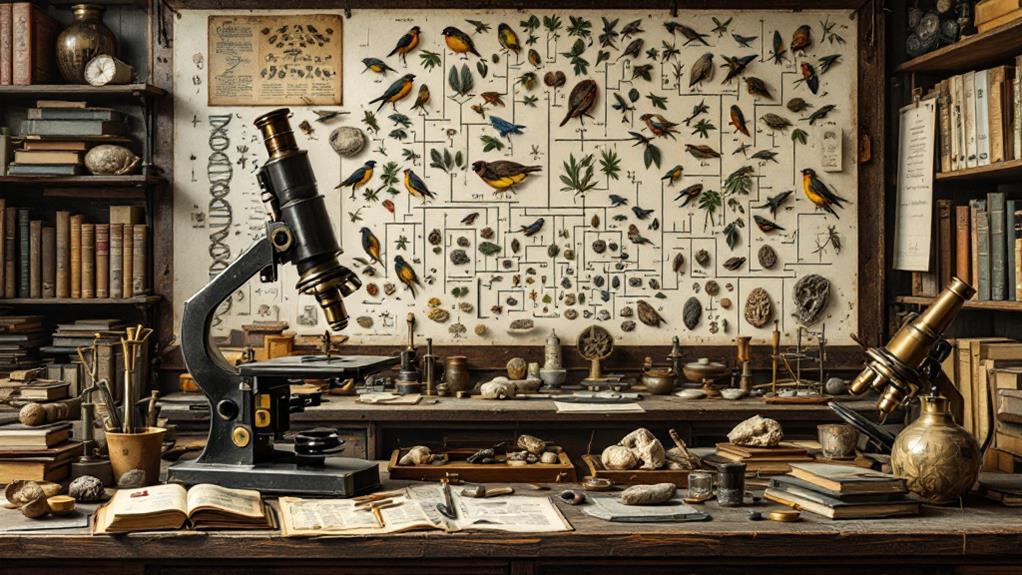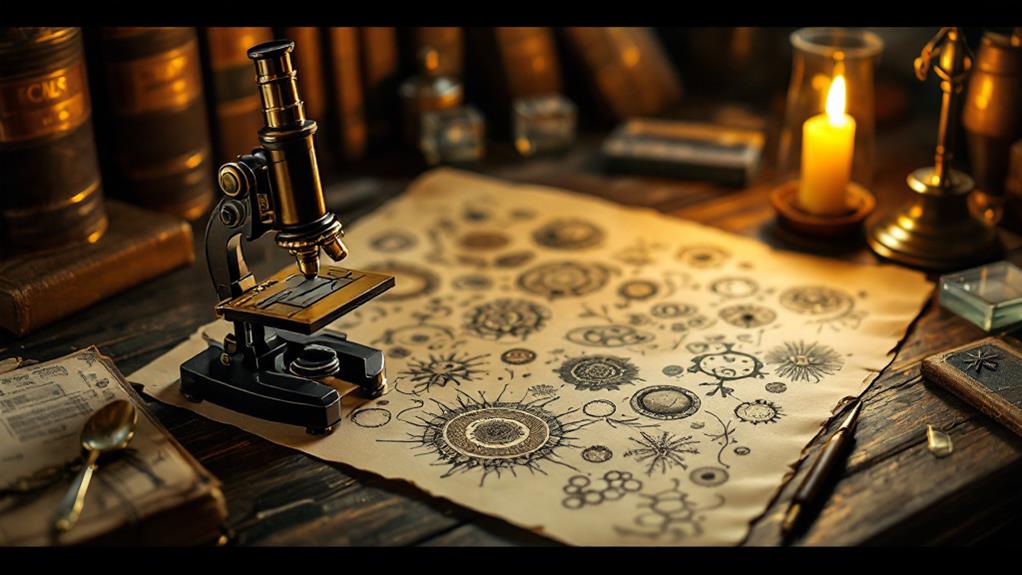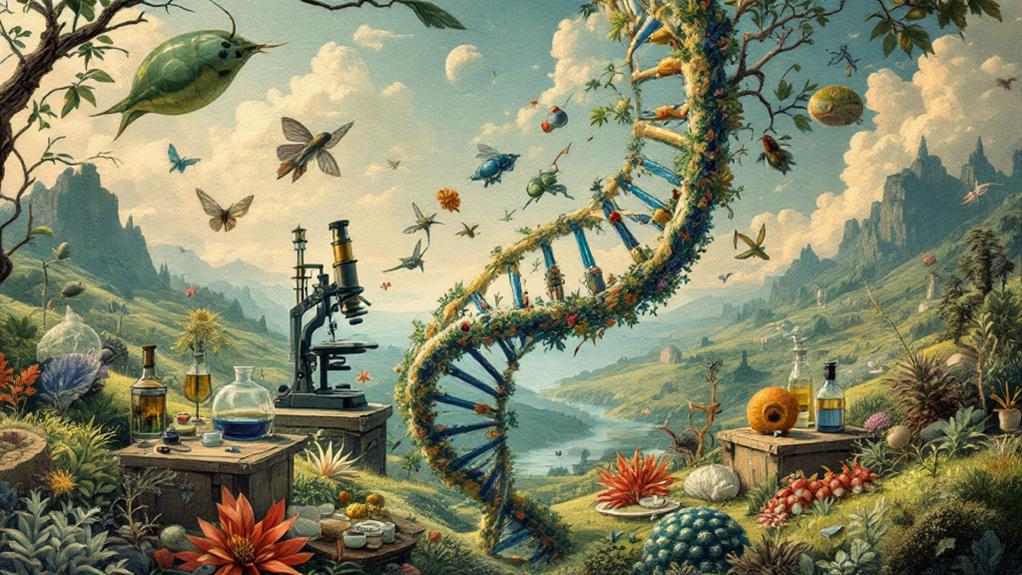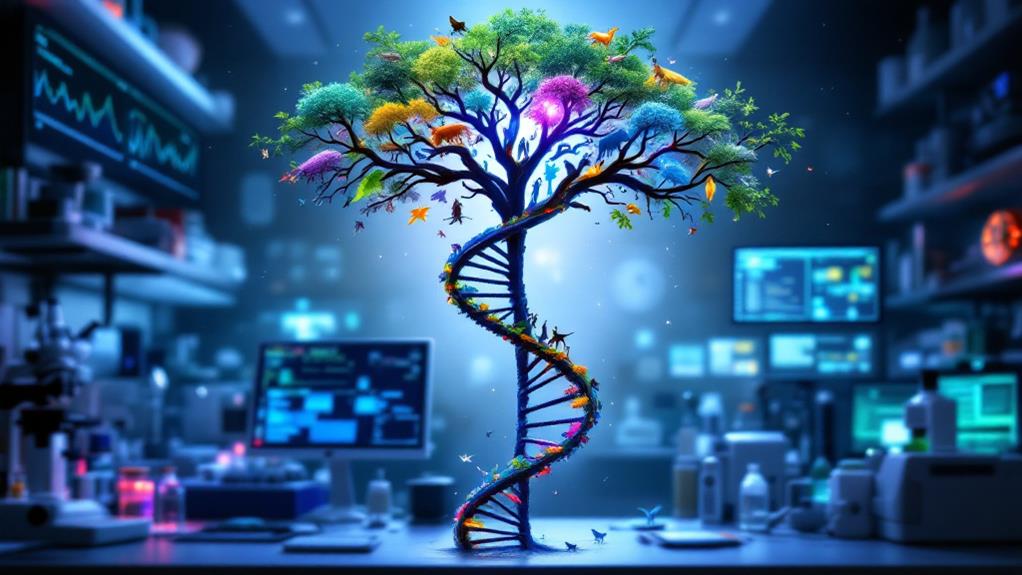The History of Biology: From the Study of Life to the Science of Evolution

Biology's expedition from ancient observations to the science of evolution is a captivating narrative. You'll see how early civilizations developed rudimentary classification systems, which gave way to scientific inquiry during the Renaissance. Cell theory and microscopy revolutionized our understanding of life's building blocks. Darwin's theory of evolution then explained the diversity of life, while genetics unveiled the mechanisms of inheritance. The molecular biology revolution decoded DNA's secrets, leading to the Modern Synthesis. Today, fields like Evo-Devo and systems biology continue to expand our knowledge. There's much more to uncover about biology's rich history and its impact on our understanding of life.
Ancient Observations and Classifications
Dating back to ancient civilizations, the study of biology began with keen observations of the natural world. You'll find that early humans were deeply attuned to their surroundings, noting patterns in plant growth, animal behavior, and seasonal changes. These natural world observations formed the foundation of biological knowledge.
Ancient Egyptians, Mesopotamians, and Chinese civilizations developed rudimentary classification systems for plants and animals. You'd see that they categorized organisms based on their uses, habitats, or physical characteristics. In Greece, Aristotle made significant contributions by creating one of the first comprehensive taxonomic systems, grouping animals by their similarities.
Early taxonomic systems, while primitive by today's standards, were pivotal in organizing biological information. You'd notice that these classifications often reflected cultural beliefs and practical applications rather than genetic relationships. For instance, plants might be grouped by their medicinal properties or edibility.
As you investigate further, you'll uncover that these ancient observations and classifications laid the groundwork for future scientific inquiry. They sparked curiosity about the diversity of life and set the stage for more systematic approaches to studying biology in later centuries.
Renaissance and Early Modern Period
Ushering in a pioneering age of scientific inquiry, the Renaissance and Early Modern Period marked a significant shift in biological understanding. You'll find that this era challenged long-held beliefs, including the ancient Humoral theory, which had dominated medical practice for centuries.
As you investigate this period, you'll notice the emergence of scientific methods, revolutionizing how biological knowledge was acquired and verified. You'll see how figures like Andreas Vesalius reshaped anatomy through direct observation and detailed illustrations, debunking many of Galen's misconceptions.
You'll uncover that the invention of the microscope opened up a whole new world of cellular biology. Anton van Leeuwenhoek's observations of microorganisms shattered previous notions about the limits of life's complexity.
In botany, you'll find that taxonomic systems began to evolve, with John Ray introducing the concept of species based on shared characteristics. Meanwhile, William Harvey's work on blood circulation demonstrated the power of experimental approaches in physiology.
This period set the stage for modern biology, establishing foundational principles and methodologies that would shape the field for centuries to come.
Cell Theory and Microscopy

Building on the foundations laid during the Renaissance, cell theory emerged as a cornerstone of modern biology in the 19th century. You'll find that this development was closely tied to advancements in microscopy, which allowed scientists to uncover the microscopic world of living organisms.
In 1665, Robert Hooke first observed and described plant cells using a primitive microscope. This revelation paved the way for further investigations into cell structure and function. As microscopes improved, researchers like Matthias Schleiden and Theodor Schwann proposed that all living things are composed of cells, laying the groundwork for cell theory.
The ability to observe cells in greater detail led to the identification of various organelle structures within them. You'll see how this knowledge expanded our understanding of cellular processes and cell communication. Scientists uncovered that cells interact with their environment and each other through complex signaling pathways.
Cell theory revolutionized biology by providing a unifying concept for understanding life. It's become the basis for studying everything from genetics to evolution, shaping our modern view of living systems and their intricate workings.
Darwin's Theory of Evolution
Charles Darwin's theory of evolution stands as one of the most influential scientific ideas in history. You'll find its impact reaching far beyond biology, shaping our understanding of life's diversity and development.
Darwin's groundbreaking work, "On the Origin of Species," introduced the concept of natural selection. This mechanism explains how species adapt to their environments over time. You'll see how organisms with advantageous traits are more likely to survive and reproduce, passing these traits to future generations.
The phrase "survival of the fittest" encapsulates this idea, though Herbert Spencer coined it, not Darwin. You'll notice how this concept applies to various species, from bacteria to complex mammals.
Darwin's theory challenged prevailing beliefs about the immutability of species. You'll appreciate how it provided a scientific explanation for the diversity of life, without resorting to supernatural causes.
As you investigate Darwin's work, you'll understand its profound implications for biology, genetics, and our place in the natural world. It's a testament to careful observation, logical reasoning, and the power of scientific inquiry.
Genetics and Heredity

While Darwin's theory explained the mechanism of evolution, it didn't account for how traits were passed down through generations. This gap was filled by the field of genetics, which began with Gregor Mendel's pea plant experiments in the mid-1800s. Mendel's work, though initially overlooked, laid the foundation for our understanding of heredity.
You'll find that genetics revolutionized biology by revealing the existence of genes and chromosomal inheritance. In the early 20th century, scientists like Thomas Hunt Morgan further developed these concepts, demonstrating that genes are located on chromosomes. This discovery paved the way for understanding how genetic information is transmitted from parents to offspring.
As you delve deeper into the subject, you'll encounter the concept of gene expression, which explains how genetic information is used to produce proteins and other functional molecules. This process is crucial for understanding how traits are manifested in organisms. The field of genetics continues to evolve, with recent advances in molecular biology and genomics providing unparalleled insights into the mechanisms of heredity and the complexity of life itself.
Molecular Biology Revolution
The molecular biology revolution of the mid-20th century marked a turning point in our understanding of life at its most fundamental level. You'll find that this period saw rapid advancements in techniques and knowledge, allowing scientists to probe deeper into the biochemical processes that govern living organisms.
During this time, you'd witness the discovery of DNA's structure by Watson and Crick in 1953, which laid the foundation for understanding genetic inheritance at the molecular level. This breakthrough led to the development of new tools and methods for studying genes and proteins, such as DNA sequencing and recombinant DNA technology.
As you investigate this era, you'll encounter the unfolding of molecular mechanisms behind gene expression, protein synthesis, and cellular signaling. Scientists decoded the genetic code, elucidated how enzymes catalyze reactions, and uncovered the intricate pathways of metabolism. These discoveries revolutionized our comprehension of how cells function and interact.
The molecular biology revolution didn't just advance scientific knowledge; it also paved the way for practical applications in medicine, agriculture, and biotechnology. You'll see how this period set the stage for modern genomics, personalized medicine, and genetic engineering.
Modern Synthesis and Beyond

Building on the molecular biology revolution, the Modern Synthesis emerged as a unifying structure in biology. It combined Darwin's theory of evolution by natural selection with Mendelian genetics, population genetics, and paleontology. This synthesis provided a comprehensive framework for understanding how evolution occurs at the genetic level and how it shapes populations over time.
As you investigate deeper into modern biology, you'll encounter new fields that have expanded our understanding of evolution. Evolutionary developmental biology, or "evo-devo," explores how developmental processes influence evolutionary change. It's revealed that small genetic changes can lead to significant morphological differences between species.
Systems biology has further revolutionized the field by studying biological systems as complex networks of interacting components. This approach has allowed scientists to model and predict how organisms respond to environmental changes and how evolution shapes these responses.
The Modern Synthesis continues to evolve, incorporating new discoveries from genomics, epigenetics, and ecology. You're witnessing a dynamic period in biology where our understanding of life's complexity and interconnectedness grows ever deeper.



